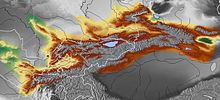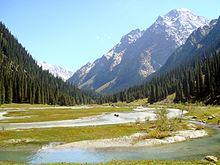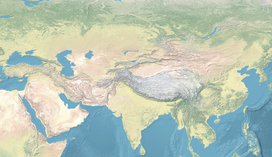Tian Shan
This article may require copy editing for grammar, style, cohesion, tone, or spelling. (July 2023) |
| Tian Shan 天山 | |
|---|---|
| Tengri Tagh, Tengir-Too | |
 The Tian Shan range on the border between China, Kazakhstan and Kyrgyzstan with Khan Tengri (7,010 m) visible at center | |
| Highest point | |
| Peak | Jengish Chokusu |
| Elevation | 7,439 m (24,406 ft) |
| Coordinates | 42°02′06″N 80°07′32″E / 42.03500°N 80.12556°E |
| Geography | |
| Countries | China, Kazakhstan, Kyrgyzstan, Uzbekistan and Tajikistan |
| Range coordinates | 42°N 80°E / 42°N 80°E |
| Geology | |
| Age of rock | Mesozoic and Cenozoic |
Asia | |
Asia | |
The Tian Shan (
One of the earliest historical references to these mountains may be related to the Xiongnu word Qilian (traditional Chinese: 祁連; simplified Chinese: 祁连; pinyin: Qílián), which, according to Tang commentator Yan Shigu, is the Xiongnu word for "sky" or "heaven".[4] Sima Qian, in the Records of the Grand Historian, mentioned Qilian in relation to the homeland of the Yuezhi, and the term is believed to refer to the Tian Shan rather than the range 1,500 kilometres (930 mi) further east now known as the Qilian Mountains.[5][6] The name of the Tannu-Ola mountains in Tuva has the same meaning. The Chinese name Tian Shan is most likely a direct translation of the traditional Kyrgyz name for the mountains, Teñir Too.[1]
The Tian Shan is sacred in Tengrism. Its second-highest peak is known as Khan Tengri, which may be translated as "Lord of the Spirits".[7] At the 2013 Conference on World Heritage, the eastern portion of Tian Shan in western China's Xinjiang Region was listed as a World Heritage Site.[8] The western portion in Kazakhstan, Kyrgyzstan, and Uzbekistan was then listed in 2016.[9]
Geography
Tian Shan is north and west of the
In Western cartography as noted by the
The Tian Shan are a part of the Himalayan orogenic belt, which was formed by the collision of the Indian and Eurasian plates in the Cenozoic era. They are one of the longest mountain ranges in Central Asia and stretch some 2,900 kilometres (1,800 mi) eastward from Tashkent in Uzbekistan.[3]
The highest peak in the Tian Shan is
The Torugart Pass, at 3,752 metres (12,310 ft), is located at the border between Kyrgyzstan and Xinjiang. The forested Alatau ranges, which are at a lower altitude in the northern part of the Tian Shan, are inhabited by Turkic-speaking pastoral tribes.
The Tian Shan are separated from the
Continuous permafrost is typically found in the Tian Shan starting at the elevation of about 3,500-3,700 m above sea level. Discontinuous alpine permafrost usually occurs down to 2,700-3,300 m, but in certain locations, due to the peculiarity of the aspect and the microclimate, it can be found at elevations as low as 2,000 m.[10]
Glaciers in the Tian Shan Mountains have been rapidly shrinking and have lost 27%, or 5.4 billion tons annually, of its ice mass since 1961 compared to an average of 7% worldwide.[11] It is estimated that by 2050, half of the remaining glaciers will have melted.
One of the first Europeans to visit and the first to describe the Tian Shan in detail was the Russian explorer
Ranges
The Tian Shan have a number of named ranges which are often mentioned separately (all distances are approximate).

In China the Tian Shan starts from about 600 to 400 kilometres (370 to 250 mi) east of



In
As for the area south of the
Ice Age
The Tian Shan plateau, stretching 100 to 120 km wide, is located on the northern margin of the
Similarly, strong glaciation was present in the high mountain area of the
Altogether, the glacial Tian Shan glaciation occupied an area of approximately 118,000 square kilometers. The glacier snowline was about 1200m lower during the last ice age than it is today. This would result in a depression of the average annual temperature of 7.2 to 8.4 °C for the Last Glacial Maximum compared with today, assuming a comparable precipitation ratio.[12]
Ecology
The Tian Shan holds important forests of Schrenk's Spruce (
The Tian Shan in its immediate geological past was kept from glaciation due to the "protecting" warm influence of the Indian Ocean monsoon climate. This defined its ecological features which could sustain its distinctive ecosphere. The mountains were subjected to constant geological changes with constantly evolving drainage systems which affected the patterns of vegetation, as well as exposing fertile soil for newly emerging seedlings to thrive in.
Tulips originated in the Tian Shan Mountains. The plant then made its way to Turkey via the Silk Road and became a symbol of the Ottoman Empire.[17]
Ancestors of important crop vegetation were established and thrived in the area, among them: apricots (). The Tian Shan region also included important animals like bears, deer, and wild boar, which helped to spread seeds and expand ecological diversity.
Among the vegetation colonizing the Tian Shan came, likely via birds from the east, the ancestors of what we know as the "sweet" apple. The fruit probably then looked like a tiny, long-stalked, bitter apple something like Malus baccata, the Siberian crab. The pips may have been carried in a bird's crop or clotted onto feet or feathers.
What natural features of the unique Tian Shan might have contributed to this rigorous selection program? Time is, as we have seen, not a problem. The turnover of individual trees is likewise conducive to the rapid evolution of a tree species, as is the fact that sweet apples are now, at least for all practical purposes, self-incompatible—that is, they cannot pollinate themselves. Therefore each apple tree within the forest and even each pip, usually five, within each individual fruit will be different. There are many apples on a mature tree, so natural selection has a rich and diverse population upon which to work. Birds, of course, eat all manner of fruit. But most birds eat seeds—a dietary feature not conducive either to the selection or spread of a fruit tree. Sweet apples are often eviscerated by birds, but the seeds are frequently left in the empty shell of the pome. The reason is that apple (and pear and quince) seeds are rich in cyanoglycosides, which are highly repellent, particularly to birds... Moreover, the placenta of the apple fruit, the womb, contains inhibitory substances that prevent the germination of the apple seed in situ. This is a commonly observed phenomenon in fruits as Michael Evenari showed in 1949. So what then does, or did, distribute the original apple seed? The bear...
—Barrie E. Juniper[18]
Climate
Tian Shan has a alpine climate (Köppen climate classification ETH).
| Climate data for Tian Shan (Urumqi Glacier No.1 (elevation 3,539 m (11,611 ft), 1991–2020 normals, extremes 1981–2010) | |||||||||||||
|---|---|---|---|---|---|---|---|---|---|---|---|---|---|
| Month | Jan | Feb | Mar | Apr | May | Jun | Jul | Aug | Sep | Oct | Nov | Dec | Year |
| Record high °C (°F) | 0.4 (32.7) |
2.2 (36.0) |
8.5 (47.3) |
13.2 (55.8) |
15.5 (59.9) |
15.6 (60.1) |
19.2 (66.6) |
18.5 (65.3) |
16.4 (61.5) |
11.2 (52.2) |
6.5 (43.7) |
3.2 (37.8) |
19.2 (66.6) |
| Mean daily maximum °C (°F) | −10.8 (12.6) |
−8.6 (16.5) |
−4.1 (24.6) |
1.3 (34.3) |
5.0 (41.0) |
8.7 (47.7) |
10.8 (51.4) |
10.5 (50.9) |
6.9 (44.4) |
0.9 (33.6) |
−4.8 (23.4) |
−8.9 (16.0) |
0.6 (33.0) |
| Daily mean °C (°F) | −15.3 (4.5) |
−13.5 (7.7) |
−9.5 (14.9) |
−4.3 (24.3) |
−0.2 (31.6) |
3.7 (38.7) |
5.9 (42.6) |
5.3 (41.5) |
1.5 (34.7) |
−4.1 (24.6) |
−9.5 (14.9) |
−13.4 (7.9) |
−4.4 (24.0) |
| Mean daily minimum °C (°F) | −19.1 (−2.4) |
−17.6 (0.3) |
−13.8 (7.2) |
−8.4 (16.9) |
−4.2 (24.4) |
0.0 (32.0) |
2.2 (36.0) |
1.6 (34.9) |
−2.2 (28.0) |
−7.8 (18.0) |
−13.2 (8.2) |
−17.2 (1.0) |
−8.3 (17.0) |
| Record low °C (°F) | −39.7 (−39.5) |
−34.7 (−30.5) |
−31.2 (−24.2) |
−24.6 (−12.3) |
−18.8 (−1.8) |
−12.9 (8.8) |
−6.9 (19.6) |
−14.4 (6.1) |
−17.5 (0.5) |
−21.8 (−7.2) |
−36.4 (−33.5) |
−35.5 (−31.9) |
−39.7 (−39.5) |
| Average precipitation mm (inches) | 2.5 (0.10) |
4.5 (0.18) |
11.8 (0.46) |
34.3 (1.35) |
59.6 (2.35) |
108.3 (4.26) |
133.8 (5.27) |
98.7 (3.89) |
40.8 (1.61) |
14.1 (0.56) |
5.8 (0.23) |
2.9 (0.11) |
517.1 (20.37) |
| Average precipitation days (≥ 0.1 mm) | 3.6 | 5.5 | 9.0 | 14.4 | 18.4 | 21.6 | 23.1 | 19.4 | 13.7 | 8.5 | 4.7 | 3.6 | 145.5 |
| Average snowy days | 5.0 | 6.5 | 9.9 | 14.9 | 19.1 | 15.2 | 9.8 | 9.3 | 13.4 | 10.0 | 5.6 | 4.4 | 123.1 |
| Average relative humidity (%)
|
48 | 50 | 52 | 59 | 63 | 70 | 71 | 67 | 61 | 54 | 50 | 48 | 58 |
| Mean monthly sunshine hours | 144.1 | 172.5 | 231.0 | 250.5 | 250.8 | 215.9 | 212.7 | 232.7 | 225.2 | 208.4 | 153.4 | 134.2 | 2,431.4 |
| Percent possible sunshine | 49 | 57 | 62 | 62 | 55 | 47 | 46 | 55 | 61 | 62 | 54 | 48 | 55 |
| Source: China Meteorological Administration[19][20] | |||||||||||||
| Climate data for Tian Shan (Kyrgyzstan weather station), 1991–2020 normals | |||||||||||||
|---|---|---|---|---|---|---|---|---|---|---|---|---|---|
| Month | Jan | Feb | Mar | Apr | May | Jun | Jul | Aug | Sep | Oct | Nov | Dec | Year |
| Daily mean °C (°F) | −19.4 (−2.9) |
−16.8 (1.8) |
−10.9 (12.4) |
−4.5 (23.9) |
−0.1 (31.8) |
3.3 (37.9) |
5.6 (42.1) |
5.0 (41.0) |
1.4 (34.5) |
−5.1 (22.8) |
−12.1 (10.2) |
−17.3 (0.9) |
−5.9 (21.4) |
| Source: NOAA[21] | |||||||||||||
Religion
Tengrism
In Tengrism, Khan Tengri is the lord of all spirits and the religion's supreme deity, and it is the name given to the second highest peak of Tian Shan.[7]
See also
Notes
- Old Turkic: 𐰴𐰣 𐱅𐰭𐰼𐰃, Tenğri tağ: Tyan-Shan / Tangritog‘, Тян-Шан / Тангритоғ, تيەن-شەن / تەڭرىتاغ
- Turkish: Tanrı Dağı
- Mongolian: Тэнгэр уул, Tenger uul
- Uyghur: تەڭرىتاغ, Tengri tagh, Тәңри тағ
- Kazakh: Тәңіртауы / Алатау, Táńirtaýy / Alataý, تٵڭٸرتاۋى / الاتاۋ
- Kyrgyz: Теңир-Тоо / Ала-Тоо, Tengir-Too / Ala-Too, تەڭىر-توو / الا-توو
- Uzbek
References
Citations
- ^ a b Prichard, James (1844). History of the Asiatic Nations. Vol. IV (3rd ed.). p. 281.
- ^ "Ensemble Tengir-Too". Aga Khan Trust for Culture. Archived from the original on 5 July 2019. Retrieved 5 July 2019.
- ^ ISBN 978-0-89577-087-5.
- ^ 班固 (2015-08-20). 漢書: 顏師古註 Hanshu: Yan Shigu Commentary. Archived from the original on 2023-01-14. Retrieved 2016-09-10.
祁連山即天山也,匈奴呼天為祁連 (translation: Qilian Mountain is the Tian Shan, the Xiongnu called the sky qilian)
- S2CID 162211306
- ISBN 978-0-500-05101-6.
- ^ ISBN 978-1900988612. Archivedfrom the original on 14 January 2023. Retrieved 11 September 2016.
- ^ "新疆天山成功申遗". Archived from the original on 2013-06-27. Retrieved 2013-06-22.
- ^ "Western Tien-Shan". UNESCO World Heritage Centre. United Nations Educational, Scientific and Cultural Organization. Archived from the original on 7 July 2018. Retrieved 17 July 2016.
- ISBN 978-7-5623-0484-5
- ^ Naik, Gautam (August 17, 2015). "Central Asia Mountain Range Has Lost a Quarter of Ice Mass in 50 Years, Study Says". Wall Street Journal. Archived from the original on August 18, 2015. Retrieved August 18, 2015.
- ^ ISBN 7-5029-1800-0.
- ^ Kuhle, M.; Schröder, N. (2000). "New Investigations and Results on the Maximum Glaciation of the Kirgisen Shan and Tian Shan Plateau between Kokshaal Tau and Terskey Alatau". In Zech, W. (ed.). Pamir and Tian Shan. Contribution of the Quaternary History. International Workshop at the University of Bayreuth. Bayreuth, University Bayreuth. p. 8.
{{cite book}}: CS1 maint: location missing publisher (link) - ^ ISBN 0-444-51462-7.
- S2CID 140639502.
- Salon. Archivedfrom the original on August 9, 2020. Retrieved March 15, 2020.
- ^ Great Courses: 'The Botanist's Eye'(DVD 2 chapter 7) by Catherine Kleier, PhD from California Polytechnic State University.
- JSTOR 27858899.
- ^ 中国气象数据网 – WeatherBk Data (in Simplified Chinese). China Meteorological Administration. Retrieved 10 October 2023.
- ^ 中国气象数据网 (in Simplified Chinese). China Meteorological Administration. Retrieved 10 October 2023.
- ^ "Tian Shan Climate Normals 1991-2020". National Oceanic and Atmospheric Administration. Archived from the original on 2024-04-14. Retrieved April 14, 2024.
Sources
- The Contemporary Atlas of China. 1988. London: Marshall Editions Ltd. Reprint 1989. Sydney, NSW: Collins Publishers Australia.
- The Times Comprehensive Atlas of the World. Eleventh Edition. 2003. London, England: Times Books Group Ltd.
External links
- Russian mountaineering site Archived 2013-04-24 at the Wayback Machine
- Tien Shan
- Bealby, John Thomas (1911). . Encyclopædia Britannica. Vol. 26 (11th ed.). pp. 909–911.
- United Nations University (2009) digital video "Finding a place to feed: Kyrgyz shepherds & pasture loss": Shepherd shares family's observations and adaptation to the changing climate in highland pastures of Kyrgyzstan's Tian Shan mountains Accessed 1 December 2009



